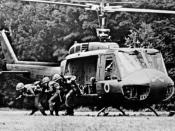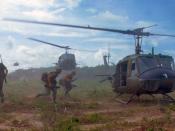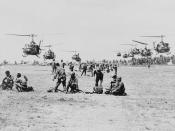Helicopters played a minor role in World War II. However, World War II demonstrated that the helicopter could perform useful missions, and they did see service to a limited extent as supply craft and for rescue operations in the China-Burma-India theatre, and were operated by the 1st Air Commando unit. But the helicopters of the day were still limited in their power, size, and hence their capabilities.
By Korea, helicopters were more numerous but were still limited largely to support roles, primarily search and rescue and medical evacuation, not to combat. Both the U.S. Army and the Marine Corps also used them in certain logistical roles. Although army leaders thought about using helicopters to ferry troops during Korea, the service was prohibited from operating large aircraft by a law passed when the U.S. Air Force was created in 1947. This situation changed on November 4, 1952, when the army and the air force signed an agreement that continued the limit on the size of army fixed-wing aircraft but redefined helicopters by function performed in the combat zone.
This new agreement paved the way for the use of large army helicopters, although it came too late to seriously impact the war. The army did, however, send the 6th Transportation Company helicopters (H-19s) to Korea before the war ended.
The United States first used this new concept of warfare, soon named "air mobility," during the early years of its involvement in the Vietnam conflict. The Vietnam War was the first real helicopter war. The army quickly began refining its way of fighting as the war escalated. American H-21 helicopters manufactured by Vertol were used to ferry Army of the Republic of Vietnam (ARVN) troops into battle against communist Viet Cong guerillas in 1962. At first, communist troops fled when the troop-carrying...


